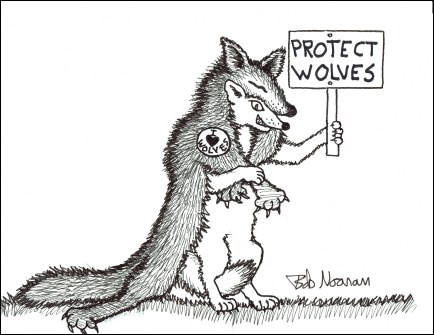


Copyright©2011-25 by Trapper's Post - All Rights Reserved
Website by Hawk Mountain Designs
Sample Articles
TRAPPER'S POST
Exclusively Trapping
September/October 2017 issue


Trapper's Post
Article Archives
Rebranding the Eastern Coyote








Trapper's Post
Article Archives






The logic is simple: unlink the Eastern coyote from its western counterpart by declaring the Coywolf a distinct species of wolf.
As a distinct species, the Coywolf would now qualify for federal protection under the Endangered Species Act.

Some of the earliest references to the term Coywolf come from a blogger/researcher/animal protectionist named Jonathan Way, who resides in Massachusetts. Since 2010 Way has written extensively arguing for the change in name from Eastern coyote to Coywolf. Way has also petitioned to have the scientific name of the Eastern coyote changed from Canis latrans (which it shares with Western coyotes, and which means “barking dog”) to Canis oriens (which means Eastern canine). This change in scientific nomenclature has important strategic implications for protection of the Eastern coyote, as explained later.
The above-mentioned media reports contain more than a little bit of Fake News, to use current jargon for propaganda. The most egregious of these is the claim that the East is home to a “new” canine. The Nature show first used the term “new” to describe hybridization with wolves that happened nearly a century ago! They rationalized that a century is but a moment in time, compared to eons in evolutionary time scales. Somehow, the Maine media didn’t get that nuanced concept. They portray “new” as “now”. Eastern coyotes began arriving in Maine in the 1940s, complete with all their wolf genes. There is nothing “new” in that fact.
More Fake News: Maine media reports speculate that our coyotes are becoming bigger and more wolf-like. While this assertion has been made, no one, not even the Maine State Museum exhibit, presents data to back this claim up. In fact, our coyotes are not getting bigger; they are unchanged from those in the 1970s and 1980s. Based on the results of seven studies from the 1970s to the late 1990s, whole-body weights of hundreds of coyotes from Maine, Quebec, Ontario, New Brunswick, and Nova Scotia averaged 34.1 lbs. for males and 29.7 lbs. for females. These weights were measured from coyotes of all age classes, between mid-October and early April.
Last winter, I obtained the whole-body weights from 131 coyotes entered in a coyote contest in east-central Maine. Males averaged 34.4 lbs. while females averaged 29.4 lbs. -- virtually identical to coyote weights documented decades ago! During both eras, individual weights ranged from 14 lbs. to about 50 lbs. for male Eastern coyotes, and from 14 lbs. to 42 lbs. for females. Note that young-of-the-year (juveniles born that spring) coyotes are the lightest, and they typically comprise about half the wintering population.
More Fake News: All media reports, and quotes from Dr. Work, assert that Eastern coyotes are about twice the size of Western coyotes. Again, not so! While it is true that the hybridization with wolves resulted in slightly larger body size and weight, the disparity in weight between western and eastern coyotes is not as great as is being portrayed. Here are some real data to chew on.
In his 1995 book The Eastern Coyote, Canadian wildlife biologist Gerry Parker discussed the size disparity. He cited a sample of winter whole-body weights from several hundred western coyotes, primarily from New Mexico. The average weight of 446 males was 24.4 lbs., while 338 females averaged 22.2 lbs. Hence, Eastern coyotes average only 7-10 lbs. heavier than their western counterparts. And that’s about the maximum difference. Coyotes occupying the northern prairie states and provinces tend to be larger and heavier than those from the desert southwest.
Twice the size? Hardly.
One last sticking point: diet overlap. Until recently, it was difficult to get coyote protectionists, and some biologists, to acknowledge that Eastern coyotes prey on deer. Despite the finding that venison sometimes comprises up to 80% percent of winter diets among coyotes in the Northeast, it just didn’t fit the protectionist narrative to accept that fact. The Eastern coyote was seen to be more benign and less of a conflict with hunters if the protectionists highlighted only the rodents, fruit, and carrion in Eastern coyote diets.
But lately, all that has changed with the movement to rebrand the Eastern coyote as the Coywolf. From the Nature documentary, to various Coywolf websites, to the Maine State Museum’s display narrative, the Eastern coyote/Coywolf has been declared a top predator capable of killing deer, and even moose, given the right circumstances.
Now, however, it is the lowly Western coyote that is made into a bug, fruit, and rodent-eating canine which is incapable of affecting deer populations. The truth is that Western coyotes are efficient predators of deer fawns, as are Eastern coyotes and gray wolves (and bears). Western coyotes are also notorious for their penchant for sheep, antelope fawns, and beef calves. Though we do not have antelope in the eastern U.S., our coyotes, and all wolves everywhere, also consume livestock wherever vulnerable.
It seems to me that recent information being fed to the eastern U.S. public seeks to make the Eastern coyote/Coywolf into a critter with such distinct attributes that it deserves a classification all its own. Neither a wimpy Western coyote nor a bruiser big wolf, the highly-evolved Coywolf supposedly deserves to be declared a distinct species; i.e. Canis oriens. And all the recent media attention paid to the existence of this canine, fake news and all, is intended to soft-pedal the desired change in scientific classification.
So what can be gained by declaring a coyote/wolf hybrid with less than 30% wolf DNA as a distinct wolf species? Protection from hunting, trapping, and hounding, that’s what.
Jonathan Way revealed the antis’ strategy in an opinion paper presented in the magazine International Wolf in 2012. In an article titled “Love Wolves; Hate Coyotes”, he pointed out that the public perceives wolves and coyotes very differently. Most people show great empathy for wolves, and they support complete protection of these big canines under most circumstances. Wolves have ‘cachet’ -- prestige, or appeal, as they say. And besides, wolves are not in many U.S. residents’ backyards. Coyotes on the other hand are ubiquitous, far less admired, less valued by people, and far less protected from killing. Anti-hunting organizations want to change that reality, for Eastern coyotes, at least.
Jonathan Way’s logic is simple: unlink the Eastern coyote from its western counterpart by declaring the Coywolf a distinct species of wolf.
As a distinct species, the Coywolf would now qualify for federal protection under the Endangered Species Act. Then petition the U.S. Fish and Wildlife Service to declare the Coywolf to be threatened due to excessive exploitation. If this ploy succeeds, say goodbye to coyote trapping, bait hunting, calling, and hounding in the East.
Sound far-fetched? Look at what the unholy alliance of the feds and the antis has done with Maine’s Canada lynx. Seventeen years after lynx were listed as federally-threatened, we are no closer to de-listing Maine's biologically abundant lynx today than we were on Day 1! And that listing has severely restricted trapping in much of the state. Every state in the Eastern U.S. needs to be wary of this ploy to re-brand the coyote into a faux wolf. At the very least, avoid referring to the Eastern coyote as the Coywolf.
Gerry Lavigne is a wildlife biologist who has done extensive field and academic research on both Eastern coyotes and wolves.
Trapper's Post
P.O. Box 128, Scandinavia, WI 54977
Phone: 715-445-2540 Email: office@trapperspost.com


